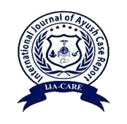Application of Snuhi Ksheer mixed Haridra powder and Teekshna Apamarga Pratisarneeya Kshara in the management of Arsha 2nd degree haemorrhoids
Abstract
Haemorrhoids are becoming one of the common problems in the society now a day. One of the another caused its existence is sedentary life style. This problem not only disturbs the daily routine but also its decreases the quality of life of a person. In Ayurveda comes under Arsha, Sushruta Acharya had explained 2 types of Arsha; Antha Arsha and Bahya Arsha. Further He had explained various types of management of both the aliments, right from surgical procedure and para- surgical procedure Antha Arsha said to be managed very well by using Kshara therapy. In this study 46 patients of 2nd degree haemorrhoids were selected and randomly divided in to two groups. In Group -A Teekshna Apamarga pratisarneeya kshara and In Group-B Snuhi Ksheer mixed Haridra powder was used. After that local application of Kshara patients were assessed for relief in symptoms like Bleeding P/R, protusion of mass, Pain. discomfort of ano region. In both the study groups, significant relief was observed in considered. The study revealed that conventional Teekshna Apamarga Kshara in better as compared to snuhiksheer mixed Haridra powder in case of 2nd degree haemorrhoids.

This work is licensed under a Creative Commons Attribution-NonCommercial-NoDerivatives 4.0 International License.

